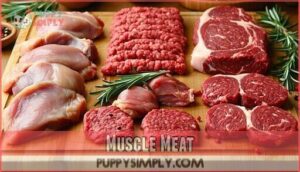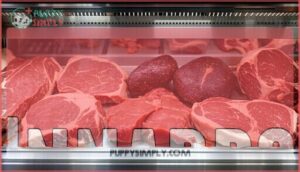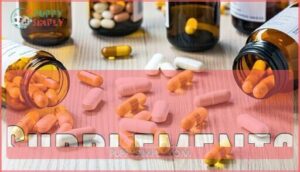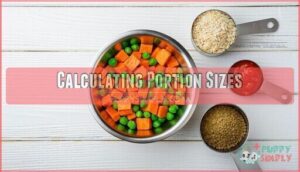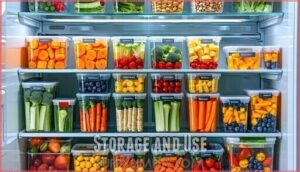This site is supported by our readers. We may earn a commission, at no cost to you, if you purchase through links.

You’ll want to focus on lean proteins like chicken, turkey, or fish since greyhounds have minimal body fat and high metabolisms.
Their sensitive stomachs often can’t handle rich foods or sudden diet changes, so introduce new ingredients gradually.
A balanced homemade diet typically includes 70% protein, 20% vegetables, and 10% carbs, but always consult your vet first.
Many greyhound owners swear by homemade meals for managing food allergies and digestive issues that plague the breed.
The key lies in understanding their racing heritage and how it shapes their dietary requirements.
Table Of Contents
- Key Takeaways
- Benefits of Homemade Dog Food
- Anatomical Basis for a Homecooked Dog Diet
- Ingredients for a Homecooked Dog Food Diet
- Where to Buy Ingredients for a Homecooked Dog Food Diet
- How to Cook a Homecooked Dog Food Diet
- Frequently Asked Questions (FAQs)
- Should I Feed my Greyhound home-cooked food?
- How much food should a greyhound eat a day?
- What ingredients are in a healthy dog food recipe?
- Does my Greyhound have a healthy gut?
- What supplements should I give my Greyhound?
- How do you make homemade dog food?
- What’s the best food to feed a greyhound?
- What is the best homemade food to feed a dog?
- What is the most important ingredient in homemade dog food?
- Can I feed my greyhound a raw food diet?
- Conclusion
Key Takeaways
- Focus on lean proteins like chicken, turkey, or fish – you’ll need 70% protein in your homemade recipes since greyhounds have high metabolisms and minimal body fat that requires quality muscle-building nutrition.
- Introduce new ingredients gradually over 7-10 days – you cannot rush dietary changes with greyhounds’ sensitive stomachs, so slow transitions prevent digestive upset and help identify food allergies.
- Include 15-25% fat content and essential supplements – you’ll want to add bone meal for calcium, fish oil for omega-3s, and probiotics since homemade diets often lack critical nutrients found in commercial foods.
- Calculate portions at 2-3% of body weight daily – you should split this into two meals for a 60-pound greyhound (roughly 1.2-1.7 pounds of food per day) and always consult your vet for proper nutritional balance.
Benefits of Homemade Dog Food
You’ll discover that homemade dog food offers targeted solutions for greyhounds with sensitive stomachs, compromised immune systems, or those serving as active working dogs who can’t handle raw diets.
This approach gives you complete control over ingredients, eliminating fillers and artificial additives while providing customized nutrition that can dramatically improve your dog’s digestive health and overall well-being.
Sensitive Stomach
When dealing with a sensitive stomach greyhound, homemade dog food becomes your best ally for managing digestive issues.
Homemade food puts you in the driver’s seat when your greyhound’s stomach rebels against everything else.
You’ll have complete control over dietary triggers, allowing ingredient elimination that commercial foods can’t offer.
Here’s what makes homemade meals effective:
- Bland base recipes – chicken and rice combinations soothe irritated digestive systems
- Probiotic support – plain yogurt additions restore healthy gut bacteria
- Digestive enzymes – fresh ingredients naturally contain beneficial enzymes
A gradual switch over 7-10 days prevents additional stomach upset while switching from kibble.
This approach helps identify specific dog food allergies causing problems.
Compromised Immune System
When your greyhound’s immune system isn’t firing on all cylinders, homemade dog food becomes your secret weapon.
You’ll control every ingredient, adding immune-boosting foods like blueberries and omega-rich fish oil.
Focus on gut health with plain yogurt containing probiotics, since 70% of immunity starts there.
Supplement options include vitamin E and zinc for infection prevention.
This approach helps with allergy management while ensuring your greyhound diet supports their compromised immune system naturally.
Active Service Dogs
Service dogs work incredibly hard, and their bodies need premium fuel to keep up.
Working dogs deserve fuel that matches their incredible dedication to service.
When you can’t feed raw but still want nutritious meals, homemade cooked food becomes your best friend.
It’s like having a personal chef for your working companion.
Homemade greyhound diet recipes with high-quality ingredients support active service dogs through:
- Energy Requirements – Customized protein and fat ratios for sustained performance
- Performance Enhancement – Nutrient-dense meals that boost focus and stamina
- Diet Customization – Personalized portions based on work intensity and body condition
- Hydration Strategies – Moisture-rich foods that support fluid balance during long shifts
- Post-Exercise Recovery – Anti-inflammatory ingredients that help muscles repair faster
Your service dog deserves nutritious meals that match their dedication to their job.
Personal Preference
Maybe you don’t want to follow commercial dog food trends or you’re concerned about recalls and questionable ingredients.
Personal preference drives many owners toward homemade dog food recipes that reflect their values. You’ll control every ingredient, ensuring greyhound nutrition meets your standards.
Whether motivated by ethical concerns, breed specifics, or simple taste preferences, dog food customization lets you create diet variety that commercial options can’t match.
Your greyhound gets meals crafted to their needs while you get peace of mind.
Anatomical Basis for a Homecooked Dog Diet
Understanding your greyhound’s anatomy helps you create meals that match their natural needs.
You’ll need to replace raw bones with bone meal, balance fat at 15-25%, include organ meats in proper proportions, and add 40-60% vegetables for complete nutrition.
Replacement for Bones
Real bones can pose serious risks to your Greyhound, but you don’t have to sacrifice essential nutrients.
Smart alternatives provide the same calcium and phosphorus benefits without the danger of splintering or choking hazards.
Here are three safe bone replacements that’ll keep your pup’s skeleton strong:
- Bone meal – Ground bones provide concentrated calcium and phosphorus in perfect ratios
- Crushed eggshells – Nature’s calcium powerhouse that’s budget-friendly and effective
- Calcium supplements – Veterinary-approved mineral supplements guarantee precise phosphorus balance
These calcium sources deliver the mineral foundation your Greyhound needs for healthy bones and teeth, making homemade meals both safe and nutritionally complete.
Ideal Fat Content
Getting the fat content right makes all the difference between a lackluster meal and one that’ll have your greyhound thriving.
Your homemade dog food recipes should contain 12-15% fat for healthy growth, though active greyhounds can handle up to 25-30%.
This isn’t just about numbers—proper fat content directly impacts your dog’s coat condition and energy levels.
To guarantee a balanced diet, consider that fat provides essential omega 3 fatty acids.
Fat delivers 2.25 times more energy than protein or carbs, making it perfect for your greyhound’s high metabolism.
Fat Sources matter enormously:
- Saturated vs. Unsaturated: Balance animal fats with fish oils for joint support
- Quality control: Fresh fats prevent vitamin destruction and maintain nutritional value
Monitor weekly weigh-ins to maintain the best body condition.
Proportions of Organs
While fat content fuels your greyhound’s energy, organ meats deliver the nutritional powerhouse your dog needs.
Think of organs as nature’s multivitamins—packed with vitamins A, B, iron, and minerals that muscle meat simply can’t match.
| Organ Type | Percentage | Key Benefits |
|---|---|---|
| Liver | 33% | Vitamin A, iron, B vitamins |
| Heart | 33% | CoQ10, taurine, protein |
| Kidney/Lung/Spleen | 33% | Minerals, enzymes, trace nutrients |
You’ll want equal parts of these animal parts to create a balanced foundation. This organ meat ratio guarantees your greyhound gets necessary nutrients without overwhelming their system with any single innard type, ensuring a healthy diet.
Inclusion of Vegetables
Vegetables pack fiber benefits and nutrient density that support your greyhound’s digestive health.
You’ll want fresh vegetables making up 40-60% of their homemade diet, with green leafy vegetables comprising at least half that amount.
Raw vs cooked preparation depends on your preference—both work well. Focus on vegetable variety with dogsafe vegetables like carrots, broccoli, spinach, and sweet potatoes.
These fiberrich vegetables aid digestion while providing essential vitamins. It’s important to know that grapes can be toxic to dogs and should be avoided.
Portion control matters, so stick to recommended percentages for ideal nutrition.
Ingredients for a Homecooked Dog Food Diet
Creating balanced homemade dog food requires four key ingredient categories that work together to meet your greyhound’s nutritional needs.
You’ll need muscle meat for protein, organ meats for vitamins, fresh vegetables for fiber, and targeted supplements to fill any nutritional gaps.
Muscle Meat
Muscle meat forms the foundation of your greyhound’s homemade recipes, delivering high-quality protein sources that support muscle maintenance and overall health. You’ll want to choose boneless meat like chicken, turkey, beef, or lamb for the best results.
Meat quality matters – fresh cuts from your local butcher work better than processed options. When preparing muscle meat, consider your cooking methods carefully.
Raw feeding enthusiasts can use pre-ground meat, while others prefer cooking at 70-90°C until thoroughly done. The grind size affects digestion, so finely chopped or ground meat works best for most greyhounds.
Many owners find it convenient to buy chewy options for their dogs. Aim for protein to make up 20-45% of your dog’s total caloric intake.
This percentage guarantees your greyhound gets enough amino acids without overloading their system. Remember, muscle meat alone won’t provide complete nutrition.
Innards
Beyond just muscle meat, innards pack a nutritional punch that’ll transform your greyhound’s health.
These organ meats deliver concentrated vitamins and minerals that regular muscle meat simply can’t match.
When you’re crafting homemade dog food recipes, innards become your secret weapon for nutrient density.
Here’s your organ variety game plan:
- Liver – Vitamin A powerhouse for immune support
- Heart – CoQ10 and B-vitamins for energy
- Kidney – B12 and iron for blood health
- Spleen – Additional iron and protein boost
Whether you’re raw feeding or cooking innards, aim for equal parts of each organ.
Raw feeding enthusiasts swear by the natural enzyme benefits, but cooking innards eliminates parasite risks.
For sourcing quality organs, your local butcher often beats grocery stores.
These nutrient-dense additions support greyhound health while keeping homemade dog food benefits front and center in your feeding routine.
Incorporating organ meat supplements can further enhance the nutritional value of your homemade dog food recipes.
Vegetables
With your greyhound’s homemade diet, adding the right vegetables creates a nutritional powerhouse that supports digestive health and overall well-being.
| Leafy Greens | Root Vegetables | Other Options |
|---|---|---|
| Collard greens | Sweet potatoes | Peas |
| Spinach | Carrots | Green beans |
| Kale | Parsnips | Celery |
| Broccoli | Beets | Squash |
Choose vegetables with high nutrient value and fiber content. Raw options like carrots provide natural teeth cleaning, while cooked sweet potatoes offer easy digestion. Vegetable variety guarantees your greyhound gets diverse vitamins and minerals essential for peak health.
Supplements
While vegetables provide fiber and nutrients, your greyhound’s vitamin needs require targeted supplementation.
Homemade diets often lack critical nutrients that commercial foods contain. You’ll need calcium supplementation when feeding exclusively homecooked meals – about 1,200 mg per pound of food balances phosphorus from meat. Fish oil delivers omega oils your dog can’t produce naturally.
Essential vitamin supplements include:
- Omega 369 oil – supports skin health and reduces inflammation
- Cod liver oil – provides vitamins A and D plus omega fatty acids
- Probiotics – maintain gut health during diet shifts
- Glucosamine – supports joint health in active greyhounds.
Mineral boost supplements like zinc prevent deficiencies common in home-prepared diets. Fiber additives aren’t usually necessary if you’re including adequate vegetables.
Always consult your vet before starting supplements. Considering the importance of joint health supplements is vital for maintaining your greyhound’s overall well-being.
Where to Buy Ingredients for a Homecooked Dog Food Diet
Finding quality ingredients for your greyhound’s homemade meals doesn’t have to break the bank or send you on a wild goose chase.
You can source fresh meats from local butchers and farmers markets, while online suppliers offer convenient options for specialized ingredients like organ meats and supplements.
Local Sources
Finding quality ingredients for your greyhound’s homemade meals starts right in your neighborhood. Local sources often provide fresher options than big-box stores, and you’ll build relationships with suppliers who understand your needs.
Start your ingredient hunt at these reliable local sources:
- Butcher Shops – Ask for organ meats and discuss bulk pricing for regular orders
- Farmers Markets – Connect directly with producers for seasonal vegetables and organic options
- Local Farms – Many sell directly to consumers, offering hormone-free meats at competitive prices
- Pet Stores – Some carry raw feeding supplies and can special-order specific cuts
Don’t overlook ethnic grocers, which often stock affordable organ meats that mainstream stores skip. Slaughterhouses sometimes sell to individuals too, though you’ll need to call ahead. Building these local connections means better prices and personalized service for your greyhound’s dietary needs.
When preparing homemade dog food, verify nutrient balance guidelines so that your greyhound receives a well-rounded diet.
Online Suppliers
Online suppliers have transformed how you source ingredients for your greyhound’s homemade diet.
Leading platforms like My Pet Carnivore and Raw Feeding Miami offer over 40 protein varieties with custom blends designed for greyhound feeding guide requirements.
Most trusted suppliers provide delivery services with orders over $150 qualifying for free shipping.
These online stores maintain rigorous quality standards, with 93% offering human-grade ingredients and detailed supplier reviews.
Subscription models help guarantee consistent availability of raw dog food components while reducing stock-out issues by 27%.
When preparing a greyhound’s meal, considering the raw dog food benefits is vital for their health, and learning about raw dog food can be very informative.
How to Cook a Homecooked Dog Food Diet
Now you’ll transform your carefully sourced ingredients into nutritious meals that’ll keep your greyhound healthy and satisfied.
The cooking process requires attention to portion calculations, proper preparation techniques, and safe storage methods to guarantee your dog gets the best nutrition from every bowl, utilizing complete concepts to ensure a healthy diet.
Calculating Portion Sizes
Before determining portions, establish your greyhound’s caloric needs based on their weight and activity level. Adult greyhounds typically require 30-35 kcal per pound of body weight daily for weight management.
Calculate daily feeding amounts using 2-3% of your dog’s body weight in food. For meal frequency, split portions into two servings to support digestion.
A 60-pound greyhound needs roughly 1.2-1.7 pounds of prepared food daily. Monitor nutrient ratios carefully and adjust dog food portions based on your dog’s response to maintain ideal greyhound weight management.
Cooking Process
When preparing homemade dog food, use cooking methods like boiling, steaming, or baking to guarantee food safety while maximizing nutrient retention.
Cook ingredients at 160-180°F until thoroughly done—this temperature kills harmful bacteria without destroying essential vitamins.
For meal prep efficiency, try batch cooking larger quantities.
Steam vegetables to preserve nutrients better than boiling. Brown meats in a pan before adding other ingredients for enhanced flavor.
Recipe customization becomes easier when you master basic dog food cooking techniques. Always follow proper food safety protocols during preparation to keep your greyhound healthy and happy, using techniques like steaming to ensure the best results.
Storage and Use
After cooking your homemade dog food, proper food safety and meal planning become your best friends.
Store portions in freezerproof storage containers and refrigerate for up to five days—your fridge becomes command central for portion control.
For longer shelf life, freeze meals for up to three months.
Dog food storage solutions work best when you label containers with dates.
Always thaw frozen portions completely before serving, and trust your nose—if something smells off, toss it.
Smart dog food storage tips include dividing large batches into single-serving containers for easier homemade dog food storage and freezer storage management.
A balanced diet requires essential vitamins and minerals for ideal health.
Frequently Asked Questions (FAQs)
Should I Feed my Greyhound home-cooked food?
Absolutely transformative for your greyhound’s health! You’ll control every ingredient, eliminate harmful additives, and tailor nutrition to their specific needs. Homemade food reduces digestive issues and boosts energy levels substantially.
How much food should a greyhound eat a day?
Your greyhound needs 250-300 grams of meat daily, plus vegetables and supplements. Feed roughly 1 pound of food per 25 pounds of body weight, adjusting for your dog’s activity level and age.
What ingredients are in a healthy dog food recipe?
You’ll need high-quality protein like chicken or beef, healthy fats from fish oil, fiber-rich vegetables such as carrots and spinach, plus essential vitamins and minerals for complete nutrition.
Does my Greyhound have a healthy gut?
While you might think gut health isn’t obvious, your greyhound’s daily habits reveal everything.
Watch their bowel movements, energy levels, and appetite patterns.
Consistent, firm stools and steady eating habits indicate a healthy digestive system working properly, showing steady eating habits.
What supplements should I give my Greyhound?
Consider omega-3 fish oil, probiotics, and a quality multivitamin designed for dogs.
Bone meal provides calcium if you’re making homemade food.
Always consult your vet before adding supplements to confirm they’re right for your specific greyhound’s needs.
How do you make homemade dog food?
Start by choosing lean proteins like chicken, beef, or turkey as your foundation.
Combine cooked meat with steamed vegetables, whole grains like brown rice, and essential supplements including calcium and omega fatty acids for complete nutrition.
What’s the best food to feed a greyhound?
Your greyhound’s stomach deserves restaurant-quality nutrition, not mystery kibble! You’ll want high-quality protein like chicken or beef, healthy fats, and vegetables—homemade beats commercial every time.
What is the best homemade food to feed a dog?
You’ll want balanced homemade meals combining high-quality protein like chicken or beef, healthy fats from fish oil, fiber-rich vegetables, and complex carbohydrates for sustained energy and peak health.
What is the most important ingredient in homemade dog food?
High-quality protein serves as your dog’s nutritional cornerstone, building strong muscles and supporting essential functions.
You’ll want to prioritize animal-based sources like chicken, beef, or fish, which should make up 20-45% of their daily calories for ideal health and energy.
Can I feed my greyhound a raw food diet?
Yes, you can feed your greyhound a raw diet with proper planning.
Raw diets include pre-ground meat, vegetables, eggs, and flaxseed oil.
Always consult your veterinarian first to guarantee nutritional balance and safety.
Conclusion
Switching to greyhound homemade dog food transforms your retired racer’s health when you understand their unique needs.
You’ll notice improved digestion, better weight management, and fewer allergic reactions within weeks of switching.
Remember to introduce new ingredients gradually and maintain proper protein-to-vegetable ratios.
Most importantly, work with your veterinarian to guarantee nutritional balance.
Your greyhound’s sensitive system deserves this personalized approach to nutrition for peak health.
- https://towcester-racecourse.co.uk/the-ultimate-guide-to-greyhound-nutrition-ensuring-performance-and-well-being/
- https://pubmed.ncbi.nlm.nih.gov/11131600/
- https://thecaninehealthnut.com/fat-in-homemade-dog-food/
- https://mypetnutritionist.com/post/essential-fats-for-my-dogs-diet-the-ultimate-guide/
- https://www.houndsy.com/blogs/modern-tails/understanding-what-is-a-low-fat-diet-for-dogs-a-comprehensive-guide


